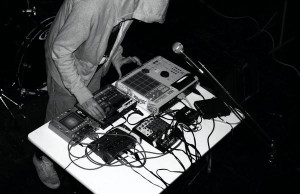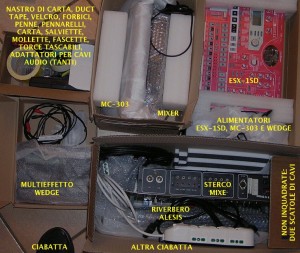My issue is not that syncing = bad. […] In the Lisbon club scene, DJs use free software to sync tracks with incredibly complex rhythms—usually tracks that were produced by the DJ or one of his or her crew—blending them together at breakneck speed. The best DJs in the experimental club music style move rapidly between genres and tempos using CDJs, their sets rarely adhering to standard beatmatching.
[…] There is, of course, a whole […] side of DJing that aligns itself closer to live performance, a style of which Hawtin is an advocate. DJs like Surgeon, Paula Temple, Speedy J and Chris Liebing use individual technological solutions to do things that are not possible with a standard CDJs or turntable setup. When this style is done well, the DJ is, in effect, improvising, pulling tracks apart and reassembling them in new and interesting ways. My feeling is that more could be done to audibly show the audience how this technique affects the tracks and parts of tracks that are being played, but regardless of this, there’s no question that syncing the music is vital to this type of performance.
CDJ, Sync e creatività
Steevio: Live Techno, Polyrhythms and Modular Synthesizers
“I got bored of hearing the same 4/4 motifs like snare drums and claps on the beats 2 and 4, which is the common house method of punctuating the rhythm,” Steevio states. “I just sat down and said I’ll never ever use those things, so it leaves it open to me mixing different polyrhythms together to make new rhythms.”
[…] Steevio sits on the reams of recorded material he generates, as his understanding of the modular way develops, letting months pass by until revisiting the results and whittling them down to workable tracks. With an ever-strengthening command over his music in the instant that it’s being produced and moving away from laborious arranging and editing, it’s palpable to see the correlation with his rock band roots. “It’s just like practicing on an instrument,” Steevio enthuses. “When you first start you’re a bit clumsy. You haven’t quite got the control, but as you go along you get slicker and slicker.”
It’s safe to say there aren’t many artists producing tracks quite like Steevio at the moment, and he’s the first to acknowledge that it’s difficult at times to see where his brand of bumping, complex techno fits in at a time when Ostgut Ton and Sandwell District rule the day.
From “Modular techno, acid rock and Freerotation: A discussion with Steevio” (pubblicato originariamente su Junodownload)
Rough and direct live sets are more enjoyable
There is an interesting difference between the computer music presenter and a live act. While the centered tape operator has perfect conditions for creating the best possible sound, for presenting a finished work in the most brilliant way (which might occasionally even include virtuoso mixing desk science rather than static adjustment to match room acoustics), the live act has to fight with situations which are far from perfect and at the same time is expected to be more lively. Given these conditions, it is no wonder that generally rough and direct live sets are more enjoyable, while the attempt to reproduce complex studio works on a stage seem more likely to fail.
A rough sounding performance simply seems to match so much more the visual information we get when watching a guy behind a laptop. Even if we have no clue about their work, there is a vague idea of how much complexity a single person can handle. The more the actions result in an effect like a screaming lead guitar, the more we feel that it is live. If we experience more detail and perfection we most likely will suspect we are listening to pre-prepared music. And most of the time we are right with this assumption.
From “Live Performance in the Age of Supercomputing” by Robert Henke
Why draw a line between audience and artist?
Da un’intervista a Burnt Friedman
Why would anyone want to perform behind the PA system? There is no reason for it since there are no microphones. When you have microphones, you have feedback issues. But an environment that’s solely set up for electronic equipment, you don’t have these problems, so why would you have people setting up behind the system? Then they are the only ones who are not hearing the sound properly. And why draw a line between audience and artist? To me it’s a rock music kind of thinking that you need someone to focus on, someone who’s more or less on the stage.
Do you often perform on the floor in front of the stage?
I always do it when possible, but more often when it’s just me alone. If it’s a band with drums, we need the stage because it’s something nice to look at. You get someone drumming in the right way and you see how it identifies with the rhythms, with the computer rhythms. It’s really nice to watch.
But with DJ equipment, and especially DJing without records, the performance can only be very poor onstage because nobody knows what’s going on. The stage is ideal for dance choreography, for theatre and for music as well, but if you can’t watch the music, if you don’t understand how they produce the music, the whole concept falls apart. If you play your tracks off the USB stick, which is technically logical and understandable because you have a much wider repertoire, and you are using CD players, I mean, there is no reason why you would perform a spontaneous mix out of fresh new tracks, it could easily be made up, especially in the environment where you have the responsibility for 2,000 people.
Do you think there’s reason to suspect those DJs?
I don’t suspect it, but you could say the situation suspects it. Imagine someone who’s not an insider, who doesn’t know about CD players, who doesn’t know about turntables—he would assume that it’s completely automatic. I’m always trying to look upon things from an outsider perspective, to get a more objective impression of what’s happening. Like an alien, extra-terrestrial point of view if you like. As far as possible, at least.
So when you’re playing and people can’t see what’s going on, that makes you uncomfortable?
Yeah, it makes me feel uncomfortable, absolutely. Ideally I would perform in an ensemble. Each sequence that is played back would be performed by someone and I would be playing my part as well. But you can imagine that this is almost impossible today.
Cos’hanno in comune Defunken, Gold Panda e i Throbbing Gristle?
Gold Panda live, la mano destra sull'electribe
…probabilmente niente, tranne che usiamo tutti, tra le altre cose, la Korg ESX-1.
Vado a fare una jam session, ecco cosa mi porto
Sto per uscire di casa con tutta la strumentazione – stasera faccio una jam session / workshop autogestito di macchinari elettronici musicali con alcuni amici.
Ho pensato di condividere foto ed elenco delle cose che mi sto portando dietro, anche come promemoria personale per il futuro.

